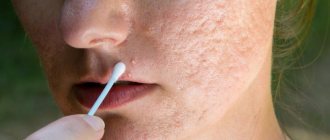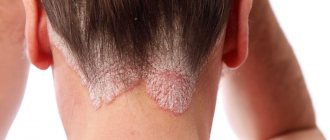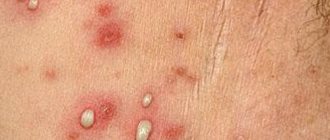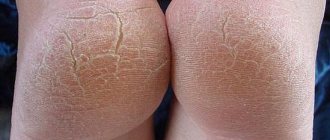What is psoriasis
Psoriasis is a chronic lesion of the skin and its appendages. The disease is characterized by periodic exacerbation and subsidence of the process. It is believed that this skin pathology is incurable. However, psoriasis is the most studied skin disease. There are several theories about the occurrence of the psoriatic process. Common to all etiological factors are manifestations of pathology. Red spots covered with white scales appear on the skin. The affected areas are accompanied by itching of varying severity. The disease most often occurs in young people with fair skin. Psoriasis affects not only the skin, but also the appendages. Psoriasis, localized in the area of the external genitalia, nails and joints, is quite rare.
Classification of psoriasis according to ICD-10
According to the international classification of diseases, psoriasis is assigned the code L40. This means that it belongs to papulosquamous disorders (from the Latin papula - “nodule” and squama - “scales”).
L40.0 Psoriasis vulgaris
Other names: plaque-shaped. It is diagnosed in almost 90% of patients. It appears as papules with a scaly structure. The plaques may be gray, silvery-white, or pinkish in color. Papules sometimes grow, connect with neighboring ones and form into entire “islands” or “lakes”.
L40.1 Generalized pustular psoriasis
Other names: exudative, impetigo, Zumbusch's disease. Considered the most severe form; manifests itself as bubbles or blisters filled with an inflammatory substance - exudate. If the blister opens and an infection gets inside, psoriasis becomes purulent. Most often, such blisters are found on the arms and legs, less often on the body.
L40.2 Acrodermatitis persistent
Other names: Crocker's dermatitis, Setton's dermatitis. The contents of pustules (pustules) formed with this form of psoriasis are sterile, so acrodermatitis is not an infectious disease. The main disadvantage is that plaques can form on the fingers, which can cause the nails to peel off.
L40.3 Pustulosis of the palms and soles
Other names: pustular bacterid. As the name suggests, this type of psoriasis affects the feet and palms. They become covered with small and large pustular formations, which gradually grow and increase in area. The contents of pustules are sterile, but pustular bacterid is considered a serious disease. Treatment is complicated by the fact that the pustules are constantly exposed to mechanical stress (they wear out and open when walking).
L40.4 Guttate psoriasis
It appears as small purple dots scattered on the thighs, legs, forearms, shoulders, head, neck and back. Often develops after suffering from streptococcal sore throat or pharyngitis.
L40.5-7 Arthropathic psoriasis
Other names: psoriatic arthropathy, psoriatic arthritis. The disease affects about 10% of all patients with psoriasis. Affects joints and connective tissue. Externally it manifests itself as swelling of the phalanges of the fingers and toes. Less commonly it affects the hip, shoulder, knee joints and spine. Sometimes it leads to disability: the patient cannot move.
L40.8 Other psoriasis
Other names: inverse psoriasis. It manifests itself as smooth, inflamed spots that hardly peel off and are localized in the folds of the skin and on the folds (in the groin, on the elbows, on the external genitalia, under the mammary glands, etc.). Difficulties in treating other psoriasis are associated with constant friction of the affected areas, as well as sweat secretion in the folds of the skin. Inverse psoriasis is often caused by a fungal infection.
L40.9 Psoriasis, unspecified
This includes all other forms of psoriasis that do not fit into any of the above.
→ More photos of different forms of psoriasis
Stages of psoriasis
In its development, skin lesions go through several stages. Among them are:
- Progressive . This stage is accompanied by the active development of symptoms of the disease. New lesions appear on the skin, the size of existing elements increases, and the lesions are accompanied by severe itching.
- Stationary . During this period, the acute process subsides. The development of new lesions stops. The patient's condition is assessed as stable.
- Regressive . The condition of the skin improves significantly. In the center of the lesion, areas of healthy skin appear. Itching stops bothering the patient. The presence of psoriasis is indicated only by the remaining pigmentation in the affected area.
Depending on the severity, there are 3 stages of pathology. When less than 3% of the skin is affected, mild psoriasis develops. When 3 to 10% of the skin is affected, a moderate degree of the disease develops. When more than 10% of the surface is involved, severe psoriasis is determined. If joint damage is involved in the pathology, then this is regarded as a severe degree of psoriasis.
Types of psoriasis
Psoriasis is classified according to four criteria.
Based on the form:
- pustular;
- non-pustular.
According to the characteristics of the course:
- Generalized subtype. The rarest (1% of cases). Reddish spots form on the skin in a short time, merging with each other. It most often appears on the arms, groin and fold areas.
- Exudative. It forms as a secondary disease against the background of diabetes mellitus or thyroid pathologies. Manifests itself in the release of the liquid component of blood.
- Plaque-like. The most common (85% of cases). One or several papules with scales on the surface appear on the skin, which can then merge into one formation. Localization is practically unlimited. There are many photos of early stage psoriasis on the head.
- Teardrop-shaped. Papules are drop-shaped.
- Atypical. It happens rarely. It is distinguished by the atypical location of the rash.
Based on location (can be combined):
- limbs;
- face;
- torso (photo of the initial stage of psoriasis on the body of an adult, photos of other stages are abundant on the Internet);
- head;
- nail plates.
Based on the stage of development:
- Initial stage. First, a small spot or pimple appears with a purple or reddish undertone. It has silvery scales that extend well from the skin. In the case of psoriasis, photos of the initial stage are available in large quantities on the Internet.
- Progressive. The papules are getting larger. They merge into a single spot without definite defined boundaries.
- Stationary. New papules are no longer formed. Old formations stop growing and turn pale.
- Regressive. Formations decrease in size.
Pathology is cyclical. In each new cycle, all four stages are repeated.
Symptoms
Psoriasis has characteristic clinical symptoms, regardless of the cause. However, there are rashes with similar symptoms, which leads to situations that require differentiated diagnosis of psoriatic lesions. Depending on the type of skin rash and its location, the following types of pathology are distinguished:
- Seborrheic. This type of rash is most often localized in the scalp area. Characterized by itchy skin and severe peeling.
- Exudative. In addition to itching and peeling, it is accompanied by the appearance of papules that become crusty.
- Plantar. Localized on the soles and feet. Psoriatic rashes of this type are characterized by dry skin, the appearance of cracks and thickening.
- Teardrop-shaped. Multiple papules localized in different places.
- Onychia. A form of pathology that is located on the nails. They become deformed and change color.
Common to all types of psoriatic rashes is the presence of rash and itching. In the absence of timely treatment, the condition worsens and the lesions of psoriasis spread.
What is phototherapy? Treatment, types of phototherapy, what are its advantages, complications and side effects.
What is common plaque or vulgar psoriasis and how to treat it, see here - ordinary psoriasis.
Forecast for life with psoriasis, is it possible to die from the disease, read here - the consequences of psoriasis.
Psoriasis of the breast and mammary glands after childbirth
After childbirth, a woman's body undergoes hormonal changes.
If a woman has had cases of psoriasis in her family, then she also has a tendency to dermatological pathologies of a similar nature.
After delivery, the woman is weakened. Lack of sleep and worry about the baby reduce immunity and increase the likelihood of developing lichen planus.
Often in the second or third month after childbirth, rashes form in the chest area. They interfere with feeding the baby and cause severe discomfort.
Causes of psoriasis
The occurrence of psoriasis is associated with various provoking factors. Numerous studies into the causes of the disease have led to the emergence of several theories. In this regard, there are several reasons that contribute to the occurrence of psoriasis.
- Burdened heredity. If blood relatives have the disease, the risk of developing skin lesions increases. At the moment, heredity is one of the main causes of psoriasis.
- Smoking and alcohol abuse.
- Individual skin characteristics. Thin and sensitive skin is the most common cause of psoriatic lesions.
- Excessive exposure to external factors. One of the reasons for the development of skin pathology is frequent contact of the skin with chemical, alcohol, and detergent solutions.
- Immunodeficiency states. Having HIV increases the risk of developing psoriasis. The reasons for this predisposition have not been fully proven.
- Taking certain medications. These include anticonvulsants, antidepressants, and antimalarials.
- Allergy. Any allergic skin rashes are a predisposing cause of the development of psoriasis.
- Stress. Excessive nervous tension provokes the occurrence of psoriatic rashes. Stressful conditions quite often become the cause of the development of pathology, as well as its exacerbation.
Parasitic diseases
The causes of psoriasis in men and women have common predisposing factors. One of them is parasitic diseases. Harmful substances produced by the parasite have a toxic effect on the body. This provokes the development of psoriatic rashes.
Silicon deficiency in the body
Violation of silicon metabolism reliably leads to the occurrence of many diseases. This condition is one of the reasons for the development of psoriasis. An insufficient amount of silicon leads to impaired absorption of many micro- and macroelements.
What causes psoriasis on the chest?
Doctors have not yet identified any clear reasons that provoke the development of psoriasis, while many doctors insist on the heredity of the disease. So, if a mother had psoriasis at one time or another in her life, then with a 70% probability her unborn child will develop it.
Some factors increase the risk of developing psoriasis on the chest:
- Malfunctions of the immune system;
- Problems in the functioning of the endocrine system;
- Previous serious infectious diseases, especially in childhood;
- Metabolism problems;
- Excessive consumption of alcoholic beverages;
- The presence of allergic reactions to certain allergens;
- Constantly being in psycho-emotional tension;
- Constant and uncontrolled use of medications.
As psoriasis develops, rashes appear on exposed areas of the skin or in areas that are constantly in contact with clothing, and the surrounding skin turns red. When the first symptoms of a problem appear, you should immediately contact a dermatologist, who will diagnose the disease and prescribe further treatment.
Remember that the earlier treatment was started, the more successful and effective it will be.
Classic diagnosis of psoriasis
Diagnosis of psoriatic rashes is not difficult. Psoriasis has a rather specific clinical picture. To make an accurate diagnosis, the following tests are used:
- Scraping test. This causes increased peeling of the skin.
- When skin scales are removed, blood spots form (blood dew phenomenon).
- Traumatization of the affected area leads to the appearance of new foci of psoriasis.
A general blood and urine test will determine the presence of an inflammatory process in the body. During a survey of the patient, the doctor can establish the presence of a family history, as well as determine the reasons that provoke the development of rashes.
The latest methods for diagnosing the disease
Causes of breast psoriasis
Numerous scientific and clinical studies have failed to establish the exact causes of the development of psoriasis, in particular the inverse form.
An important condition for the manifestation of the disease is genetic predisposition. The following triggers activate the pathological process:
- increased sweating;
- mechanical impact;
- stress;
- weakened immune system;
- smoking;
- alcohol abuse;
- taking steroid drugs;
- various fungal infections.
Environmental factors and a person’s lifestyle influence the development of primary pathology and also cause relapses of rashes on the chest. A patient with psoriasis must maintain a protective regimen throughout his life and avoid exposure to triggers.
Treatment
Psoriasis therapy requires an integrated approach. For this purpose, medications are used, applied internally and topically. Therapy includes physiotherapeutic procedures, as well as diet. It is important in treatment to influence the causes that led to the occurrence of psoriasis.
Drug therapy
To combat the symptoms of skin diseases, drugs of various groups are prescribed. For this purpose use:
- Antihistamines. This group of drugs is aimed at combating itching and redness of the skin.
- Hepatoprotectors.
- Enterosorbents.
- Immunostimulating drugs.
- NSAIDs.
Local use of drugs is included in the complex therapy of psoriasis. Preference is given to non-hormonal drugs due to fewer side effects. To do this, use zinc or salicylic ointment, skin cap. All ointments are applied to the skin in a thin layer 2-3 times a day.
Diet
During the period of exacerbation of pathology, it is necessary to adhere to dietary nutrition. It is necessary to exclude spicy, fried, salty and smoked foods from the diet. It is not recommended to drink alcoholic beverages, strong coffee or tea, or artificial additives. The daily menu includes a sufficient amount of fiber, fresh vegetables and fruits, flax and pumpkin seeds, nuts, fish and lean meats. Errors in diet are one of the reasons for exacerbation of pathology.
Patients suffering from this disease and who know what psoriasis is, imagine the duration of treatment. Impact on the causes of pathology is part of the complex therapy of psoriatic rashes. The choice of therapy is made by a dermatologist. Medications require constant changes, as the skin becomes accustomed to the medications.
What causes psoriasis, what psoriasis on the hands looks like and how it begins, see here - psoriasis on the hands.
Read the first signs of psoriasis in children here - psoriasis in children.
How to treat psoriasis - an overview of all methods and methods of treating psoriasis, see here -
Characteristic signs of pathology development
What does psoriasis on the chest look like? One of the most remarkable features of the course of the disease is the absence of psoriatic plaques characteristic of this disease. This is due to the fact that the process of proliferation of keratinocytes is carried out differently.
Important information: What does plaque psoriasis look like: what to apply and how to remove plaques?
As the disease develops, red spots appear on the skin. Such spots do not rise above the surface of healthy skin. The most common areas of localization are the fold of skin under the mammary gland, the nipple and the skin in the armpits. All emerging pathological changes have a clear boundary. The spots tend to merge.
The skin in the area of pathological changes becomes thinner and dry. Microcracks appear in damaged areas, and the resulting wounds begin to bleed.
Itching is a symptom that does not always accompany the progression of pathology. The epidermis in the area of the affected skin takes on a glossy appearance, which is facilitated by the accumulation of excess moisture.
If areas of erosion form, serous effusion begins to appear on them. Damaged skin is easily traumatized even when in contact with clothing.
The result of injury to the skin can be the penetration of a secondary infection. At the same time, the following characteristic symptoms appear:
- Painful sensations.
- Strong burning sensation.
- Redness of the area of infection.
- Increase in local or general temperature.
If these signs appear, you should immediately consult a doctor. You should not self-medicate, as such an attitude towards the body can worsen its health.
Features of nipple psoriasis
In some women, as pathological processes in the body progress, nipple psoriasis occurs. When such a disorder occurs, damage to the nipple halos is observed. The disease can cause great discomfort to a nursing mother.
The main symptoms of this pathology are pain, itching, a burning sensation in the nipple area, the formation of a characteristic psoriatic rash on the skin and significant thinning of the skin in the affected area.
After the feeding procedure, the mother experiences the appearance of cracks and wounds. Such wounds cause secondary infection, which significantly worsens the health of the nursing mother.
Secondary infection can cause loss of breast milk and contribute to the occurrence of mastitis.
Nipple psoriasis can be treated during breastfeeding only with the use of neutral moisturizing creams based on lanolin. In especially severe cases, the use of glucocoricosteroids in small concentrations is permitted. Nutrition for psoriasis is no less important for a woman during this period.
During and after treatment, you should avoid using uncomfortable underwear that can cause irritation on the nipples.
Essential minerals and vitamins for psoriasis
Additional intake of vitamins and minerals during the period of exacerbation of psoriatic rashes, as well as for preventive purposes, is necessary to compensate for their deficiency in the body. Properly selected vitamins contribute to the rapid restoration of the skin and strengthen the nervous system. The following vitamins and minerals are used in the treatment of psoriasis:
| Vitamin A (retinol) | A fat-soluble vitamin that accelerates the regenerative properties of the skin. |
| B vitamins | Positively affect the nervous system. In this regard, vitamins of this group are actively used in the treatment of psoriasis. |
| Vitamin D | The lack of this vitamin negatively affects the condition of the skin and its appendages. Vitamin D is produced under the influence of ultraviolet light. Therefore, during short daylight hours, additional vitamin D intake is necessary. |
| Vitamin E | Refers to natural antioxidants. Thanks to this, it has a positive effect on the condition of the skin, accelerating its regeneration. |
| Folic acid | Due to its properties that promote skin restoration, the administration of folic acid is justified during exacerbation of psoriasis. |
| A nicotinic acid | Prescribed as symptomatic treatment to alleviate the condition during exacerbation of the disease |
Only a doctor can determine the required dosage after a preliminary blood test.
How and what is recommended to treat scaly lichen on the chest
The treatment regimen for breast psoriasis is selected based on the diagnostic results.
Doctors usually prescribe a set of therapeutic measures. Are used:
- medicines;
- physiotherapy;
- diet;
- vitamin therapy;
- proper care of the affected skin area.
All practiced methods allow you to quickly put the disease into a long-term stage of remission. Therefore, you should follow all doctor’s recommendations.
Traditional Treatments
Treatment begins with non-hormonal wound-healing and anti-inflammatory drugs and creams. They do not have a negative effect on the body and are allowed for women who are breastfeeding.
Popular products in this group:
- Medela PureLan. Restores lipid balance and prevents the formation of cracks in the nipples. Has a natural composition.
- Pruried. This is a cream for sensitive and dry skin with a regenerating and antipruritic effect.
- Avent. Nourishes and heals the dermis.
- Topicrem. Relieves inflammation and restores.
- Levomekol. This is an antibiotic with the immunomodulator methyluracil. Used for infection. Slows down cell division.
- D-panthenol. Ointment with pronounced anti-inflammatory properties.
External preparations are applied three times a day to the affected area. If these medications do not give a positive result, then they are replaced with glucocorticosteroids. The best anti-inflammatory hormonal drugs are Elokom, Advantan and Belosalik.
Therapy with folk remedies
To increase the effectiveness of drug therapy, it is recommended to use alternative medicine methods. There are many recipes on the Internet. But not all of them give positive results.
The most effective, according to patient reviews, are:
- Decoctions of sage, calendula, chamomile. Relieves irritation and inflammation. They are used to wipe the skin and as compresses.
- Apricot, peach, olive and avocado oils. They lubricate the affected areas several times a day.
- Honey. This product moisturizes and nourishes the skin with vitamins and beneficial microelements. Used as masks.
Thus, psoriasis only in the chest area is a rare occurrence.
This form of pathology is similar to other dermatological disorders and is difficult to diagnose. Without timely treatment, lichen planus can spread to other parts of the body and cause a number of complications. Therefore, you need to know the first symptoms of breast psoriasis and immediately consult a doctor.
Prevention
In order to minimize the risk of psoriasis relapse, you must adhere to the following recommendations:
- Follow a dietary diet. It is necessary to limit the consumption of highly allergenic foods. These include chocolate, citrus fruits, canned food, pickles, coffee and strong tea, and alcohol. It is important to take vitamins and minerals to compensate for the lack of nutrients in the body.
- Nervous psoriasis. One of the most common causes of psoriasis relapse is stress. It is recommended to avoid such situations and learn to cope with it.
- Choose clothes by size. Tight clothing can cause additional friction in areas of psoriatic rashes. You should give preference to loose clothing made from natural fabrics.
- To live an active lifestyle. An established rest regime and adequate physical activity will strengthen the body's protective functions.
- Choose the right skin care. Skin prone to psoriatic rashes requires careful and constant care. It is recommended to choose creams from pharmacies, paying special attention to their composition.
The above recommendations will help reduce the risk of exacerbation of psoriasis. If the first symptoms of the disease appear, you must consult a doctor to select the correct therapy.
Psoriasis is a chronic disease, the course of which alternates between periods of exacerbation and remission. At the moment, doctors do not identify specific causes of the pathology. By following medical recommendations for treatment, as well as adhering to the rules of prevention, you can minimize the risk of exacerbation.
Scalp damage
Let's look at another example of how psoriasis can manifest itself at the initial stage. We're talking about the scalp. It is noted that the place of localization is the area of the forehead, ears, neck, and back of the head.
The patient constantly scratches the plaques, resulting in multiple wounds and scratches. Dirt is carried into the abrasions, which leads to inflammatory reactions. Subsequently, silvery scales form, the papules connect and extend beyond the hairline.
Diagnostics
It is impossible to make an accurate diagnosis of the disease by visual examination. To confirm (or refute) the diagnosis, the patient is prescribed:
- blood tests - general and biochemical;
- immunogram;
- allergy tests;
- stool analysis for worm eggs;
- analysis - Wasserman reaction;
- laboratory examination (culture) of nipple discharge.
In parallel with the basic diagnostic methods, the patient may be prescribed dermatoscopy. If it is impossible to establish an accurate diagnosis, the patient is sent for histological examination of samples of the epidermis from the affected areas of the skin.
Often, to clarify the preliminary diagnosis, as well as to exclude the development of breast cancer, women are referred for a consultation with a mammologist.
During therapy, the patient is periodically referred for repeated laboratory tests. This allows you to assess the effectiveness and adequacy of the treatment regimen.
Forecast
It is impossible to get rid of psoriasis. With adequate treatment, stable remission can be achieved. The same basics apply to psoriasis on the chest. What complicates the diagnosis and subsequent treatment of the disease is that in the affected area (on the chest) the skin is sensitive and tender. But with competent medical participation, it is possible to “suspend” the development of the pathological process. If a person adheres to prevention, avoids exposure to negative factors on the body and maintains the proper functionality of the body with a healthy diet, then stable remission is guaranteed.
Psoriatic arthritis
Psoriatic arthritis can be considered both a type of psoriasis and arthritis. There are 5 types of the disease, we will look at the common features.
Manifestations
- the skin becomes red, bluish, purple;
- joint damage, up to deformation;
- swelling of fingers and toes.
Common sites of injury
- small finger joints;
- knee and hip joints;
- joints on the shoulders and shoulder blades;
- vertebrae
Photo
Hand deformity due to psoriatic arthritis
Leg deformity due to psoriatic arthritis










